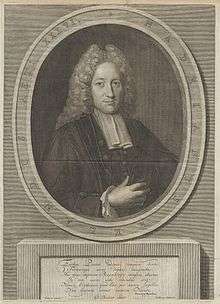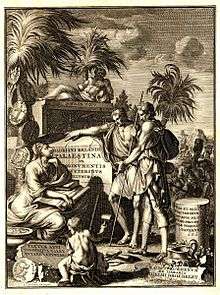Adriaan Reland

Adriaan Reland (also known as Adriaen Reeland/Reelant, Hadrianus Relandus) (17 July 1676, De Rijp, North Holland – 5 February 1718, Utrecht [1]) was a noted Dutch Orientalist scholar, cartographer and philologist.[2] He is considered to have made a long-lasting and significant contribution to research of the historical geography of early Palestine.[3]
Early life
Reland was the son of Johannes Reland, a Protestant minister, and Aagje Prins in the small North Holland village of De Rijp. Adriaan's brother, Peter (1678–1714), was an influential lawyer in Haarlem.[1] Reland first studied Latin language in Amsterdam at age 11, and enrolled at University of Utrecht in 1693, at age 17, to study theology and philosophy. Initially interested in Hebrew and Syriac, he later began studying Arabic. In 1699, after obtaining his doctorate in Utrecht, Reland moved to Leiden and tutored the son of Hans Willem Bentinck, 1st Earl of Portland.[4] The latter invited him to move to England, but Reland declined because of his father's deteriorating health.
Academic career
In 1699, Reland was appointed Professor of Physics and Metaphysics at the University of Harderwijk. By this point, he had achieved fluency in Arabic, Hebrew, and other Semitic languages.[5] In 1701, at age 25, he was appointed Professor of Oriental Languages at the University of Utrecht. Beginning in 1713, he also taught Hebrew Antiquities.[3] This was extended with a Chair in Jewish Antiquity[6].
Reland gained renown for his research in Islamic studies and linguistics; his work being an early example of comparative linguistics. Additionally, he studied Persian and was interested in the relation of Eastern myths to the Old Testament. He published a work concerning East Asian myths, Dissertationum miscellanearum partes tres, in 1708. Moreover, he discovered the link for the Malay language to the Western Pacific dictionaries of Willem Schouten and Jacob Le Maire.
Research on Middle East
Reland, through compiling Arabic texts, completed De religione Mohammedica libri duo in 1705. This work, extended in 1717, was considered the first objective survey of Islamic beliefs and practices.[7] It quickly became a reference work throughout Europe and was translated into Dutch, English, German, French and Spanish.
Reland also extensively researched Middle Eastern locations and biblical geography, taking interest in the Semitic peoples of Palestine. He published Antiquitates Sacrae veterum Hebraeorum (1708) and Palaestina ex monumentis Veteris illustrata (1714), in which he described and mapped the geography of Palestine.[3]
Reland retained his professorship for his entire life, and additionally became a noted poet. In 1718, at age 41, he died of smallpox in Utrecht.[1]
Selection of Published Works

- De religione Mohammedica libri duo - the first European attempt to systematically describe Islamic religious practices. Utrecht 1705, 1717
- Dutch Translation Verhandeling van de godsdienst der Mahometaanen, als mede van het krygs-regt by haar ten tyde van oorlog tegens de christenen gebruykelyk. Utrecht 1718
- English translation: Of the Mahometan Religion, Two books. London 1712
- German translation: Zwey Bücher von der Türkischen oder Mohammedischen Religion. Hannover 1716, 1717
- French translation: La Religion des Mahometans exposée par leurs propres Docteurs, avec des éclaircissemens sur les opinions qu'on leur a Faussement attribuées. The Hague 1721
- Palaestina ex monumentis veteribus illustrata - a detailed geographical survey of biblical Palestine, written in Latin. Published by Willem Broedelet. Utrecht 1714[8][9]
- Dutch translation: Palestine opgeheldert, ofte they gelegentheyd van het Joodsche country.
- Analecta rabbinica. Utrecht 1702, 1723
- Dissertationum miscellanearum partes tres. Utrecht 1706-1708, 3 Teile
- Antiquitates sacrae veterum Hebraeorum. Utrecht 1708, 3. uppl. 1717, 1741
- De nummis veterum Hebraeorum. Utrecht 1709
- Brevis introductio ad grammaticam Hebraeam Altingianam. Utrecht 2. uppl. 1710, 1722[10]
- De natuurlijke wijsgeer - a Dutch translation of Ibn Tufail's Arabic novel Hayy ibn Yaqdhan. Printed by Pieter van der Veer. Amsterdam 1701
- Galatea. Lusus poetica - a collection of Latin love-elegies, which brought Reland some fame as a Neolatin poet. Amsterdam 1701


Gallery
.jpg) Map of Western Java, 1718.
Map of Western Java, 1718.
References
- 1 2 3 John Gorton, A General Biographical Dictionary, 1838, Whittaker & Co.
- ↑ Power And Religion in Baroque Rome: Barberini Cultural Policies, P. J. A. N. Rietbergen, p.321
- 1 2 3 Dr. Zur Shalev, University of Haifa Digital Gallery, introduction to Reland's bookPalaestina ex monumentis veteribus illustrata
- ↑
- ↑ Adriaan Reland (1676-1718) Archived April 13, 2008, at the Wayback Machine.
- ↑ De spoliis templi Hierosolymitani in arcu Titiano Romae conspicuis Liber singularis. Acta Eruditorum. Leipzig. 1717. p. 69.
- ↑ St John's College of Cambridge University Library
- ↑ Digital gallery of University of Haifa - Books in Foreign Languages
- ↑ Hadriani Relandi Palaestina ex monumentis veteribus illustrata (1714)
- ↑
External links
- Literature on Reland in Dutch Digital Library (DBNL)
- Maps by Reland
- Complete bibliography on WorldCat
- Hadriani Relandi Analecta Rabbinica, 2-nd ed. 1723 on Google Books
- Hadriani Relandi Palaestina ex monumentis veteribus illustrata 1714 on Google Books
- Chart of Southern India by van Keulen after Hadriano Relando.
- The Heinsius-Collectie: Adriaan Reland, 1676-1718